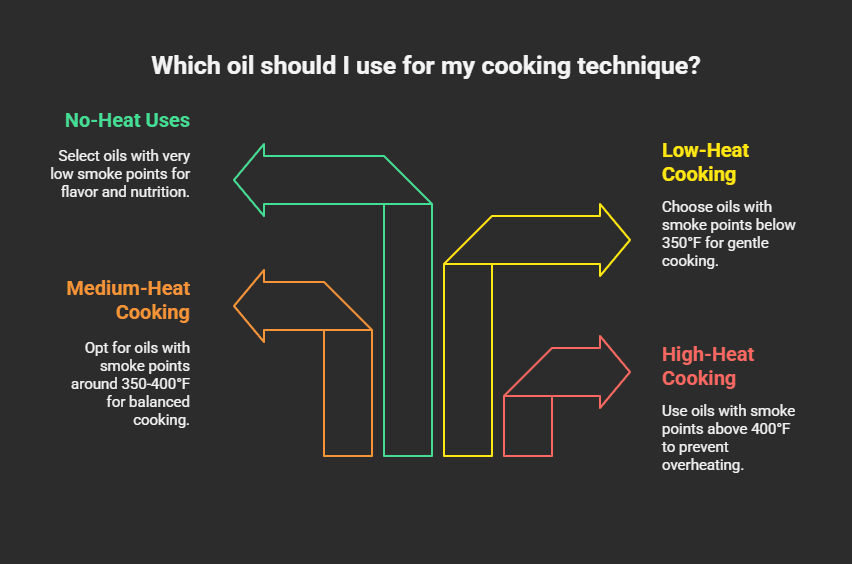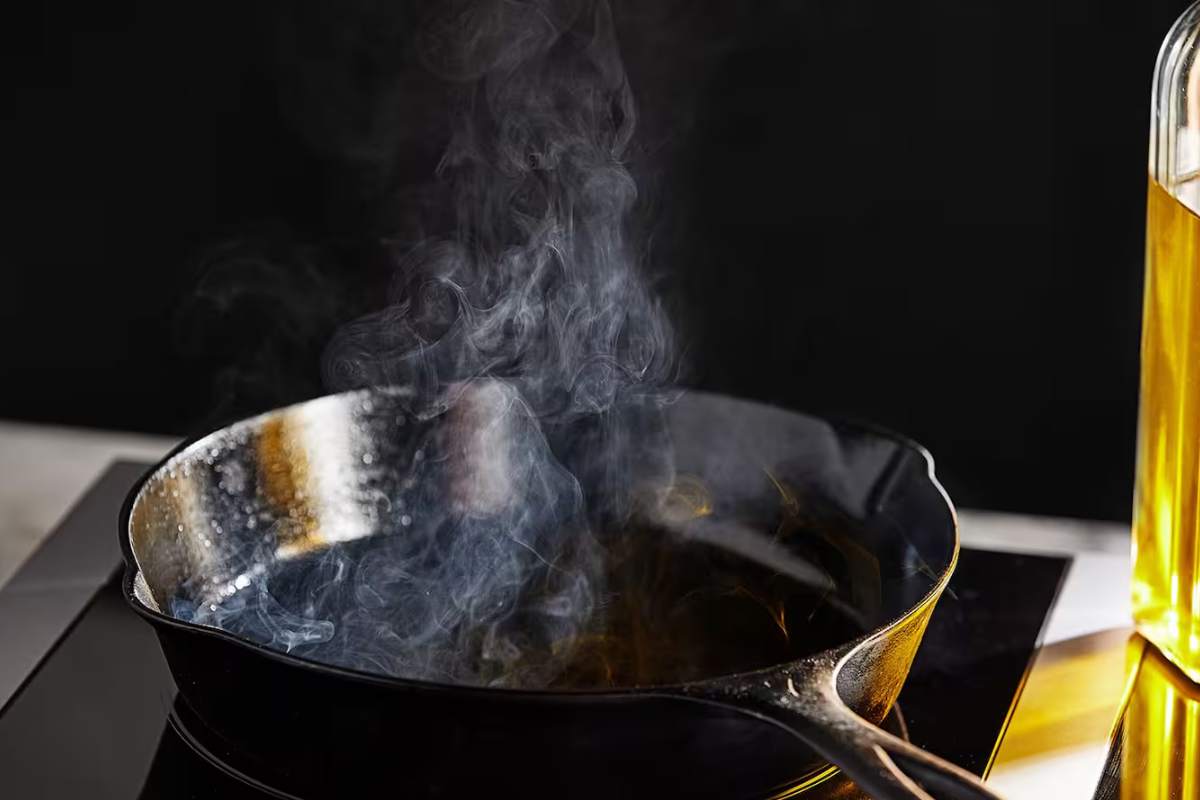In the culinary process, using the right oil is very important, and one thing to pay attention to is the cooking oil with a high smoke point. The oil you use can determine a lot about the taste, texture, and even the health factors of what you are cooking. Knowing about the smoke point is vital to any amateur cook or professional chef who wants to produce the best possible results in the kitchen.
Decoding Smoke Point: What It Is and Why It Matters
The smoke point of an oil used for cooking is the temperature at which it begins to degrade and form visible smoke. This is caused by the fats in the oil breaking down due to the heat that is applied. You may notice the oil sparkling in the pan before this occurs.
This process of breakdown is not merely a visual signal; it’s also a chemical transformation within the oil. When the oil is heated past its smoke point, it releases free radicals and a compound called acrolein. Acrolein creates the unpleasant burnt, bitter taste and acrid smell that will ruin your food. Moreover, the fumes generated will lead to watery eyes and an unwanted odor in your kitchen.
Using cooking oil beyond the smoke point also has adverse effects on your health, with the release of such toxic compounds. Free radicals are formed, which are associated with oxidative stress in the body. More importantly, as the oil deteriorates further, it approaches its flash point, the temperature at which it releases ignitable gases. While there will be no chance of spontaneous combustion in usual cooking, it remains an undesirable safety risk. Having oil with the right smoke point is essential to various methods of cooking.
Those that use a lot of heat, like searing, deep frying, and stir frying, need oils that have good heat resistance, usually over 400°F (205°C). Using an oil with a low smoke point in these processes is not only detrimental to the flavor of your food but also to its nutritional value. The repeated data shows that passing the smoke point not only impairs the taste of the food but also could be harmful to health through the release of harmful substances. This emphasizes the basic significance of knowing and taking into account smoke points in preparing with oils and fats.
The Quest for the Highest Smoke Point: Unveiling the Top Contenders
The quest for the oil that has the best smoke point is usually followed by a debate about various oils and how they are processed. Normally, refined oils will have higher smoke points than their unrefined counterparts. Refining oils eliminates impurities and free fatty acids, which are recognized to reduce the smoke point of an oil.
Among vegetable oils, refined avocado oil often finds itself to be a top candidate for having the highest smoke point. The average range of its smoke point is near 520°F (271°C).
Refined safflower oil is another oil that has a very high smoke point. Its smoke point, when averaged, is typically reported at approximately 510°F (266°C).
Surprisingly, algae oil was determined to possibly possess the absolute highest smoke point of traditionally debated cooking oils. Its smoke point can go as high as 535°F (279°C). Nevertheless, it should be added that algae oil may not be as widely accessible for consumers as some of the more popular choices, such as avocado or safflower oil.
Outside of these leading contenders, several other oils have high smoke points (over 450°F), such as refined rice bran oil, refined peanut oil, refined soybean oil, and corn oil. Refined avocado and safflower oils are always among the best performers, but algae oil has a potentially even higher smoke point. This would indicate a relatively newer or less popular choice for those who prefer cooking at very high temperatures.
A Closer Examination of High Smoke Point Cooking Oils
For a better comprehension of which cooking oil possesses the highest smoke point and which would be best for you, let’s examine a few of the best in greater detail.
Refined Avocado Oil
Refined avocado oil is obtained from the pulp of the avocado fruit and is widely valued due to its versatility as well as its high smoke point. The smoke point of refined avocado oil is often quoted as 520°F (271°C), though some sources quote a marginally lower range of 480-520°F.
The taste of refined avocado oil is, in general, deemed to be neutral, which makes it a good all-around option that won’t have a heavy impact on the flavor of your dish. Unrefined avocado oil, on the other hand, still has a very light, butty, and occasionally grassy taste.
With its high smoke point, the refined avocado oil is great for a wide range of high-heat cooking techniques such as deep-frying, searing, stir-frying, grilling, and baking. Nutritionally, it is rich in monounsaturated fats, specifically heart-healthy oleic acid. The key difference is between unrefined and refined avocado oil. The refined one values high smoke point and neutral taste and is highly versatile for high-heat procedures, while the unrefined one is more suitable for uses where its taste is wanted and lower heat is applied.
Refined Safflower Oil
Refined safflower oil comes from the seeds of the safflower plant and is also a very good choice for high-heat cooking because of its remarkable smoke point. The smoke point is often stated at about 510°F (266°C), though some state it between 450-500°F. Just like refined avocado oil, refined safflower oil possesses a mild and neutral taste. This quality makes it fit for a broad variety of food uses without overwhelming the flavor of the other food ingredients.
Refined safflower oil is suitable for high-heat cooking techniques like frying, stir-frying, sautéing, roasting, and baking. Several refined safflower oils are rich in monounsaturated fats, especially oleic acid, which makes them stable and have a high smoke point. The high oleic acid content of refined safflower oil makes it stable and can handle high temperatures, and thus it is an ideal choice for different cooking techniques where a neutral taste is desired.
Algae Oil
Algae oil is a relatively new player in the cooking oil industry and is distinguished by having a very high smoke point. It has a smoke point of as much as 535°F (279°C), which makes it one of the best choices for cooking at high heat.
The taste of algae oil is characterized as neutral and clean, which means it will not alter the flavor of your foods. That is why it is best suited for cooking at high temperatures, such as searing and deep-frying. Nutritionally, algae oil contains heart-healthy omega-9 fatty acids. Although its extremely high smoke point and neutral taste make it a great option for cooking at high heat, and its omega-9 content is a nutritional plus, its availability may be a limiting factor for some consumers over more established brands.
Comprehensive Comparison of Cooking Oil Smoke Points
For a quick reference, the following table provides a comparison of the smoke points of various common cooking oils:
| Oil Name | Refined/Unrefined | Smoke Point (°F) | Smoke Point (°C) |
|---|---|---|---|
| Refined Avocado Oil | Refined | 480-520 | 249-271 |
| Unrefined Avocado Oil | Unrefined | 350-400 | 177-204 |
| Refined Safflower Oil | Refined | 450-510 | 232-266 |
| Unrefined Safflower Oil | Unrefined | 225 | 107 |
| Algae Oil | Refined | 535-540 | 279-282 |
| Refined Rice Bran Oil | Refined | 450-490 | 232-254 |
| Unrefined Rice Bran Oil | Unrefined | 450 | 232 |
| Refined Peanut Oil | Refined | 450 | 232 |
| Unrefined Peanut Oil | Unrefined | 320-350 | 160-177 |
| Refined Soybean Oil | Refined | 450 | 232 |
| Unrefined Soybean Oil | Unrefined | 320 | 160 |
| Refined Corn Oil | Refined | 400-450 | 204-232 |
| Unrefined Corn Oil | Unrefined | 352 | 178 |
| Refined Sunflower Oil | Refined | 450 | 232 |
| Unrefined Sunflower Oil | Unrefined | 225-320 | 107-160 |
| Light/Refined Olive Oil | Refined | 390-470 | 199-243 |
| Extra Virgin Olive Oil | Unrefined | 325-410 | 163-210 |
| Canola Oil | Refined | 400-475 | 204-246 |
| Unrefined Canola Oil | Unrefined | 375-450 | 190-232 |
| Ghee (Clarified Butter) | Clarified | 375-485 | 190-252 |
| Coconut Oil | Refined | 400-450 | 204-232 |
| Coconut Oil | Unrefined | 350 | 177 |
| Butter | Unrefined | 302-350 | 150-177 |
This table offers a convenient way for readers to compare the smoke points of various frequently used cooking oils. Including both Fahrenheit and Celsius caters to a wider audience. Specifying whether an oil is refined or unrefined is crucial because this significantly impacts its smoke point. The data presented is compiled from multiple sources to provide a comprehensive and well-rounded overview, acknowledging potential variations in reported values.
Factors That Influence a Cooking Oil’s Smoke Point
There are a number of factors that can affect the smoke point of a cooking oil. Knowing these factors will allow you to make better decisions in the kitchen.
The degree of processing, or refinement, is the most important aspect. Refining raises the smoke point by eliminating impurities like sediment and free fatty acids. Unrefined or “virgin” oils contain more of these solids, which burn at lower temperatures, causing a lower smoke point. This is why there are usually separate smoke points for the same oil, depending on whether it is refined or not.
The level of free fatty acid (FFA) content in an oil is also very important. FFAs are not as stable as fatty acids that are in triglyceride form and will smoke at lower temperatures. FFAs increase when oils are heated, and this is why repeated heating of cooking oil is usually not advisable, since it reduces the smoke point with every repeated heating.
Sedimentation, or residual solids from the oil’s processing (more common in crude oils), also influences the smoke point. The solids will burn at lower temperatures than the pure oil, lowering the smoke point overall.
Last, the storage and age of the oil can influence its smoke point as well. Exposure to air, heat, and light can also break down the oil over time, which will reduce its smoke point. Thus, it is important to store your cooking oils properly in a dark, cool place in tightly closed containers to preserve the quality and smoke point of your cooking oils. Processing level is the most significant factor that determines a cooking oil’s smoke point. It explains why the refined and unrefined forms of the same oil tend to have varied smoke points.
Pairing Smoke Point to Cooking Technique:

Selecting the right oil with the correct smoke point for your cooking technique is the key to maximizing results and preventing the adverse effects of overheating oil. For cooking techniques involving high heat, such as deep-frying, searing, and stir-frying, oils with smoke points higher than 400°F (205°C) are preferable. Some good options in this group are refined avocado oil, refined safflower oil, algae oil, refined peanut oil, refined soybean oil, refined corn oil, and light refined olive oil.
Medium-heat cooking, such as sautéing, pan-frying, and baking, is ideally suitable for oils of medium smoke point, commonly around 350-400°F (177-204°C). The following are oils of such type: unrefined avocado oil, extra virgin olive oil, refined coconut oil, grapeseed oil, and canola oil.
Low-heat cooking, including gentle sautéing and low-heat baking, uses oils with lower smoke points, typically below 350°F (177°C). Choices here include unrefined coconut oil, unrefined sesame oil, and butter.
For no-heat uses such as salad dressings and finishing oils, oils with very low smoke points may be employed. These oils, for example, flaxseed oil, walnut oil, and other non-refined nut oils, tend to be selected for their specific flavors and nutritional values when consumed raw. Various cooking techniques require varying amounts of heat and, therefore, varying smoke points.
Offering specific oil recommendations for each technique provides useful advice and aids the reader in putting their knowledge of smoke points into practice.
Beyond the Smoke: Other Key Considerations When Cooking Oils
Though the smoke point is important, it’s not the only detail to pay attention to when selecting a cooking oil. The taste of an oil can greatly influence the flavor of your finished dish. Neutral oils, like refined avocado, safflower, canola, vegetable, corn, soybean, rice bran, and peanut oil, are safe choices and won’t overwhelm the other flavors in your dish. Conversely, oils with strong flavors, such as olive oil, sesame oil, and nut oils, may impart distinctive and favorable attributes to specific foods.
The nutritional value of various cooking oils is also a significant factor to consider. Oils have different types of fats, such as monounsaturated, polyunsaturated, and saturated fats, with varying health effects. Certain oils are also higher in certain vitamins or antioxidants, which can also play a role in overall health.
Lastly, the price and accessibility of some oils may also determine a consumer’s decision. Although a high smoke point may be preferable for some types of cooking, the usability of accessing and paying for a specific oil is also important to many home cooks. Although smoke point is a top consideration, flavor, nutrition, and usability are also important considerations that people make when choosing cooking oils. Recognizing these elements gives a more holistic view.
Conclusion: Making Knowledgeable Choices for High-Heat Cooking.
Knowing the smoke point of oils used for cooking is very important, particularly when using high-heat cooking techniques. By choosing an oil that can handle the temperatures needed for your method of cooking, you are better guaranteed flavor, you will keep the release of harmful chemicals to a minimum, and you will have a safer cooking space.
The best candidates for the highest smoke point cooking oil are refined safflower oil, refined avocado oil, and algae oil. Refined avocado oil provides a commonly found product with no flavor and a smoke point of approximately 520°F. Refined safflower oil provides another highly suitable option with a comparable smoke point and no taste. Algae oil is distinguished by having a higher possible smoke point of 535°F and a pure taste, if perhaps less accessible.
Finally, the optimal selection of cooking oil will be based on your particular cooking technique, as well as personal taste, nutritional requirements, and availability. By applying the information presented, you can make better choices about the cooking oils you use and enhance your culinary experiences.








